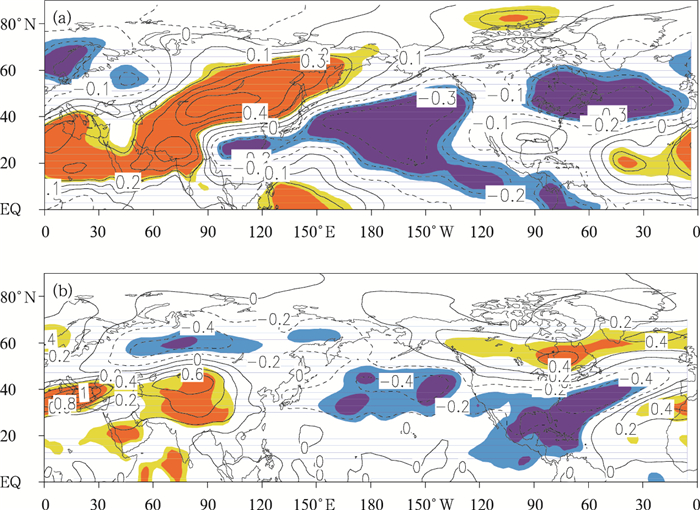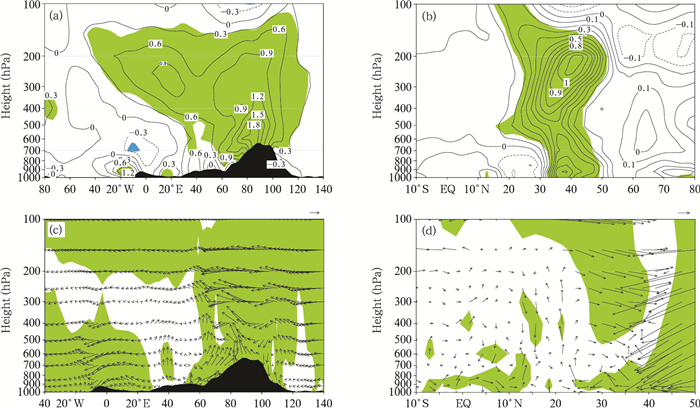中国气象学会主办。
文章信息
- 刘舸, 赵平, 南素兰, 陈军明, 王慧美. 2018.
- LIU Ge, ZHAO Ping, NAN Sulan, CHEN Junming, WANG Huimei. 2018.
- 夏季青藏高原上空热力异常与其上下游大气环流联系的研究进展
- Advances in the study of linkage between the Tibetan Plateau thermal anomaly and atmospheric circulations over its upstream and downstream regions
- 气象学报, 76(6): 861-869.
- Acta Meteorologica Sinica, 76(6): 861-869.
- http://dx.doi.org/10.11676/qxxb2018.058
-
文章历史
- 2018-06-13 收稿
- 2018-09-26 改回
2. 南京信息工程大学气象灾害预报预警与评估协同创新中心, 南京, 210044
2. Collaborative Innovation Centre on Forecast and Evaluation of Meteorological Disasters, Nanjing University of Information Science and Technology, Nanjing 210044, China
青藏高原是北半球夏季的重要热源之一,在海-陆-气相互作用中扮演重要角色。青藏高原感热气泵不仅是南亚夏季风北支和东亚夏季风形成的重要原因(Wu,et al,2012;吴国雄等,2018),而且它和有关热力指标(如高原大气热源/汇)的变化也可调节亚洲地区大气环流和降水在不同时间尺度上的变化(Zhao,et al, 2001a, 2001b;Duan,et al,2005;Wang,et al,2008;Liu,et al,2012;Wu G X,et al,2016)。近年来,很多学者也将关注点拓展到了全球范围,发现青藏高原加热及其相关变量(如积雪、感热、潜热、表面温度及对流层温度等)异常对全球很多地区的大气环流和气候异常具有重要贡献(Ose,1996;Ye,et al,1998;Zhao,et al,2007;Nan,et al,2009;周秀骥等,2009;Duan,et al,2012;Wu Z W,et al,2016;Zhu,et al,2018)。
在沿青藏高原(35°N)的平均纬向环流剖面(叶笃正等, 1979, 参见该文献图14.8)上可以看到,7月青藏高原地区存在一个强大的上升气柱,此上升气流向东的分支上升到200 hPa以上,而在日期变更线以东的东太平洋上空为下沉气流。这一气候平均垂直纬向环流暗示了青藏高原与中太平洋和东太平洋有着密切的遥相关(叶笃正等,1979)。赵平等(2008)进一步发现,在北半球中纬度纬向垂直环流的气候态背景下,当青藏高原上空上升运动加强(减弱)时,中东太平洋下沉运动也随之加强(减弱)。这种垂直环流间的联系与一个横跨北半球的大尺度遥相关——亚洲-太平洋涛动(Asian-Pacific Oscillation,简称APO)的强、弱变化紧密地关联在一起(Zhao,et al,2010)。APO联系着北半球很多关键大气环流系统,因而可以很好地指示南亚、东亚和北美等地的夏季降水异常(Zhao,et al,2012a;Zhou,et al,2015),它在东亚夏季降水短期气候预测中也是一个不可忽视的因子(陈丽娟等,2016)。在气候平均状态下,夏季副热带“四叶形”(LOSECOD)加热是形成北半球大气冷热源和相应的大尺度大气环流结构的关键因素(Wu,et al, 2003, 2009)。而从年际变化的角度来看,夏季青藏高原加热异常与APO具有一定的联系(Nan,et al,2009;周秀骥等,2009),但其机制尚不清楚。因此,本研究主要从青藏高原加热异常的角度分析夏季APO年际变化特征和机理,以期加深对北半球(特别是东亚和下游的太平洋地区)夏季气候异常的理解,进而提高短期预测水平。
另外,青藏高原加热异常引起的对流层上层温度异常也对南亚高压变化有重要影响(Zhao,et al,2009)。而南亚高压异常西伸可能对欧洲和北非等地的气候异常具有一定的调节作用。包括青藏高原在内的亚洲陆地加热甚至可以调节更遥远的北大西洋热带外地区的夏季环流和相应的海温(Zhao,et al,2012b)。最近,Lu等(2018)利用地球系统模式也发现,青藏高原表面加热可强迫出上游地区(西亚、北非、南欧和北大西洋)的气候异常。这些研究表明,青藏高原加热异常不仅影响当地及其以东(下游)地区的气候,可能对其以西(上游)地区的气候也具有一定的调节作用。然而,后者的研究相对较少,特别是从年际尺度来看,青藏高原热力异常变化是否也影响着上游地区夏季降水变化呢?显然也是值得探讨的问题。
因此,特别针对夏季青藏高原加热在年际尺度上的对上、下游影响效应,综合了最新的两项研究结果,利用观测和数值模拟揭示了夏季青藏高原热力异常与同期APO年际变化的联系及其可能机制(Liu,et al,2017)。同时,也给出了青藏高原加热调节西非萨赫勒(Sahel)地区夏季降水年际变化的过程(Nan,et al,2018)。
2 夏季青藏高原热力异常与APO的联系从气候平均状态来看,在亚洲大陆,感热和潜热加热作用可导致亚洲上空出现升温和上升运动;而在东太平洋,长波辐射冷却对应下沉运动,并可造成该地区的降温。这实际上反映了夏季副热带“四叶形”加热分布对北半球大气冷、热源结构和大尺度大气环流具有重要贡献(Wu,et al, 2003, 2009;吴国雄等,2008)。APO反映的并不是亚洲上空暖、太平洋上空冷的气候平均结构,而是在海-陆分布背景下的亚洲上空和太平洋上空温度变化的相互联系(即“跷跷板”关系)。那么,在年际变化上,作为亚洲大陆加热的重要组成部分,夏季青藏高原热力异常是否也与APO有联系呢?其联系途径又是怎样的?文中对此深入探讨。
首先,提取各变量年际变化成分后再进行分析。利用美国国家海洋和大气管理局(National Oceanic and Atmospheric Administration,NOAA)的20世纪再分析资料,对1871—2012年夏季(6—8月)对流层上层(300—200 hPa)平均纬偏温度(格点温度与同纬度纬圈平均温度的差,T′)场距平进行经验正交函数(Empirical orthogonal function,EOF)分解,发现第1模态空间分布表现为中纬度欧亚大陆和太平洋地区高空T′反向变化的“跷跷板”关系,显示出了清晰的APO结构(Liu,et al,2017)。根据这一空间分布,可简单地将中纬度欧亚大陆(30°—55°N,30°—135°E)和北太平洋(30°—55°N,165°E—120°W)两地区平均对流层上层T′的差值(前者减后者)定义为APO指数。相关分析表明,夏季APO与同期青藏高原(31°—40°N,69°—93°E和27°—40°N,93°—105°E)表面气温具有显著正相关(Liu,et al,2017)。由于在NOAA的20世纪再分析资料中,表面气温同化了很多站点的长期观测数据,与表面热通量(感热、潜热、长短波辐射等)等计算量相比具有更高的可靠性,而且青藏高原表面气温异常可以反映青藏高原加热和相应的高原上空深厚高温异常(图 2)。因此,这里将上述青藏高原地区平均表面气温定义为青藏高原热力指数(Tibetan Plateau thermal index, 简称TP指数)。1871—2012年夏季TP指数与同期高空T′场的相关也显示出较为清晰的APO结构(图 1a)。而且,夏季TP指数与APO指数的50 a滑动相关(Liu,et al,2017)进一步揭示,在过去100多年的年际变化尺度上,夏季TP指数与APO指数的显著正相关关系较为稳定,而且无论是上述NOAA的20世纪再分析资料还是1900—2010年欧洲中期天气预报中心(European Centre for Medium-Range Weather Forcasts, 简称ECMWF)的ERA 20世纪再分析资料,都显示了同样的结果。

|
| 图 1 (a) 1871—2012年夏季TP指数与同期T′场的相关系数;(b)与(a)类似,但为CAM3-Tree与CAM3-bare(前者减后者)的T′合成差异(单位:℃) (其中黄色与橙色(浅蓝与深蓝色)阴影指示超过95%和99%显著置信度的正(负)异常(Liu,et al,2017)) Figure 1 (a) Correlation coefficient between the summer TP index and concurrent T′ field during 1871-2012; (b) as in (a) but for the composite difference between CAM3-Tree and CAM3-bare (the former minus the latter) (Yellow and orange (light and dark blue) shadings denote positive (negative) differences significant at the 95% and 99% confidence levels, respectively (Liu, et al, 2017)) |

|
| 图 2 (a) NOAA 1871—2012年夏季TP指数回归的异常垂直环流(红色流线)和T′(单位:℃;等值线与阴影)的垂直结构;(b)与(a)类似,但为CAM3-Tree与CAM3-bare(前者减后者)的合成差异 (黄色与浅蓝色阴影指示超过95%显著置信度的正、负异常;黑色阴影指示地形(Liu,et al,2017)) Figure 2 (a) Spatial structure of anomalous vertical circulation (red vector lines) and T′ (unit:℃, contours and shadings) regressed onto the summer TP thermal index. The regressions are based on the NOAA-20C reanalysis data during 1871-2012; (b) as in (a) but for the composite difference between CAM3-Tree and CAM3-bare (the former minus the latter) (The positive (negative) T′ anomalies significant at the 95% confidence level are shaded in yellow (blue). The areas shaded in black denote terrain; (Liu, et al, 2017)) |
1871—2012年,夏季TP指数回归的异常垂直环流和T′的垂直结构(图 2a)显示,当青藏高原加热增强时,亚洲上空对流层温度出现大范围的升高。同时,在青藏高原北部及其邻近地区出现异常上升运动。这一上升气流在对流层高层向北偏转,在中高纬度地区(55°N附近)向东传播,至中东太平洋地区(165°W附近)逐渐向南下沉,并在较低纬度出现了补偿性上升运动。中东太平洋地区异常下沉运动引起对流活动偏弱,导致云和降水的减少,从而造成了更强的长波辐射冷却和更少的凝结潜热释放(Liu,et al,2017)。因此,中东太平洋上空对流层中高层表现为异常偏冷状态,并与亚洲上空的偏暖一起构成了正APO异常。
为了进一步揭示青藏高原热力异常与夏季APO的联系,利用美国NCAR的CAM3大气模式(Collins,et al,2004),通过改变青藏高原1500 m以上地区具有不同反照率的地表植被(分别设置为裸土和热带常绿阔叶林),模拟出了青藏高原热力异常的强迫效应。试验结果进一步证实,夏季青藏高原热力异常可激发与观测类似的亚洲和中东太平洋热带外大尺度垂直环流异常(图 2b),进而强迫出了APO型的异常结构(图 1b)。综上所述,作为“四叶形”加热的一部分,青藏高原加热增强可调整并加强气候态上的这支青藏高原-太平洋垂直纬向环流,进而与太平洋地区对流层温度产生联系,引起亚洲和太平洋上空的温度反向变化,导致APO的年际变率。
根据静力学方程,与APO正异常相对应,夏季TP指数回归的纬偏位势高度(格点位势高度与同纬度纬圈平均位势高度的差,H′)场显示,在亚洲大陆对流层高层(100 hPa, 图 3a)表现为显著正异常,而在对流层低层(850 hPa;图 3b)则为显著负异常;在中东太平洋热带外地区,对流层高层(100 hPa, 图 3a)为显著负异常,对流层低层(850 hPa, 图 3b)则为显著正异常。很明显,这种大尺度位势高度的显著变化对亚洲和太平洋地区的气候具有重要的影响。数值模拟的结果显示(图 3c、d),与观测相比,位势高度异常的位置出现了系统性偏南,这也对应着亚洲-太平洋异常垂直环流的系统性偏南(图 2b)以及APO的系统性偏南(图 1b)。初步推测可能是由于数值试验中去除了与青藏高原热力变化较为一致的亚洲区域加热的贡献,同时也可能由于对东亚中高纬度降水的模拟能力相对较差,从而低估了该地区凝结潜热加热对APO的贡献。出现这种系统性偏差的具体原因尚需今后进一步分析。尽管如此,青藏高原加热在对流层高、低层强迫出的亚洲-太平洋大尺度位势高度异常结构与观测结果大体上是一致的(图 3c、d)。

|
| 图 3 1871—2012年夏季TP指数回归的同期(a)100 hPa和(b)850 hPa H′场的异常分布;(c)和(d)与(a)和(b)类似,但为CAM3-Tree与CAM3-bare(前者减后者)的H′合成差异(单位:gpm) (黄色(红色)阴影指示超过95%(99%)统计置信度的正异常,而浅蓝(深蓝)色阴影则指示相应的负异常) Figure 3 Distributions of summer H′ at (a) 100 hPa and (b) 850 hPa levels regressed onto the concurrent TP index during 1871-2012; (c) and (d) as in (a) and (b), respectively, but for the composite difference between CAM3-Tree and CAM3-bare (the former minus the latter) (Yellow and red (light and dark blue) shadings denote the positive (negative) anomalies significant at the 95% and 99% confidence levels, respectively) |
上述观测和模拟结果的一致性表明,在年际变化尺度上,青藏高原热力异常变化可对APO的变化产生调节作用,引起北半球大范围对流层高、低层位势高度异常,进而调节亚洲和太平洋地区的气候。在年际尺度上,夏季青藏高原热力异常有可能通过亚洲和中东太平洋热带外大尺度垂直环流的途径与APO产生联系。
3 夏季青藏高原对流层温度异常与西非萨赫勒地区降水的联系1979—2014年夏季(6—9月)青藏高原对流层温度指数(定义为(25°—45°N, 65°—105°E)地区上空400—200 hPa平均温度)与同期西非萨赫勒地区降水具有显著正相关关系(图 4a)。那么,该指数又是如何与西非萨赫勒地区降水异常产生联系的呢?

|
| 图 4 (a) 1979—2014年夏季(6—9月)去趋势的青藏高原对流层温度指数与同期非洲GPCP降水的相关(十字标注表示相关系数超过95%统计置信度的区域),(b)青藏高原对流层温度异常-萨赫勒降水的物理链接机制示意(Nan,et al,2018) Figure 4 (a) Correlation between the summer (June-September) detrended Tibetan tropospheric temperature index and the detrended GPCP precipitation over Africa during the period 1979-2014, in which the areas marked by "+" indicate the correlation significant at the 95% confidence level; (b) schematic diagram of the mechanism responsible for the relationship between the Tibetan tropospheric temperature and central-eastern Sahelian precipitation (Nan, et al, 2018) |
Nan等(2018)的研究揭示了青藏高原夏季对流层温度异常影响同期萨赫勒地区降水的物理过程(图 4b),指出两者之间的关系可以用青藏高原至地中海的异常纬向垂直环流圈和地中海至非洲地区的异常经向垂直环流圈解释。在中纬度地区的对流层中高层,青藏高原异常加热引起了自青藏高原西部经中亚直至地中海的大气变暖(伴随着南亚高压的加强西扩)。这一变暖导致了该地区中纬度和副热带地区异常的温度梯度,进而引起异常纬向垂直环流:青藏高原西部地区出现异常上升气流,在对流层中上层向西偏转,并在地中海地区出现异常下沉运动。与青藏高原对流层加热对应,在西亚和东地中海到西地中海对流层之间形成一温度梯度,进而引导北非区域北哈得来环流圈的增强:地中海地区出现异常下沉运动,西非地区出现异常上升,对流层上层为异常南风,低层为异常北风。北非区域北哈得来环流圈的增强有助于非洲大陆低压的加强,同时也增强了对流层低层的西风和西南风,进而加强了从热带东大西洋向非洲大陆的水汽输送,最终引起萨赫勒降水增多。改变青藏高原地表植被的CAM3试验结果(图 5)与观测基本一致,可以看到:伴随青藏高原加热,在30°—40°N纬度带对流层中上层温度出现了从青藏高原向西直至地中海上空的显著升高(图 5a),并由此产生了从该纬度带向低纬度地区的温度梯度(图 5b)和相应的欧亚大陆纬向垂直环流(图 5c)。另外,在西亚和东地中海到西地中海对流层之间也形成了一个温度梯度(图 5a),并形成了相应的北非区域增强的经向垂直环流(图 5d)。Wu等(2015)的研究指出,夏季南亚地区对流层高层高温的形成和位置变化与其西侧(东侧)的辐射冷却(对流加热)有关,其本质上是由加热/冷却垂直梯度的空间分布特征决定的。而这里的观测和模拟结果揭示,在年际变化的尺度上,青藏高原异常加热也对高原上空及更大范围上的对流层温度具有一定的调节作用,进而通过对上游大尺度环流的调整影响同期西非萨赫勒地区的降水(Nan,et al,2018)。

|
| 图 5 CAM3-Tree与CAM3-bare(前者减后者)的夏季(6—9月)合成差异 (a.沿30°—40°N经度-高度的温度剖面(单位:℃), b.沿20°—90°E纬度-高度的温度剖面(单位:℃), c.沿30°—40°N经度-高度的垂直环流剖面, d.沿10°W—50°E纬度-高度的垂直环流剖面;阴影区为超过90%统计置信度; Nan,et al,2018) Figure 5 Summer (June-September) composite difference between CAM3-Tree and CAM3-bare (the former minus the latter) for (a) longitude-height cross section of air temperature (unit: ℃) along 30°-40°N, (b) latitude-height cross section of air temperature (unit: ℃) along 20°W-90°E, (c) longitude-height cross section of zonal vertical circulation along 30°-40°N, and (d) latitude-height cross section of meridional vertical circulation along 10°W-50°E. The shaded areas indicate the differences are significant at the 90% confidence level (Nan, et al, 2018) |
在夏季青藏高原热力异常与其上、下游大气环流年际变化联系方面,对最新的研究成果(Liu,et al,2017;Nan,et al,2018)做了简要介绍。利用观测和数值模拟发现,夏季青藏高原热力异常与同期APO的年际变化在过去100多年里具有显著且稳定的联系,前者有可能以亚洲和中东太平洋热带外大尺度垂直环流为途径与后者产生联系(Liu,et al,2017)。在气候平均状态下夏季“四叶形”加热结构可能是造成亚洲上空暖、太平洋上空冷的气候平均结构的关键因素,而在年际尺度上青藏高原热力异常变化即可影响APO的变化。另外,在年际变化的尺度上,青藏高原异常加热对高原上空及更大范围上的对流层温度变化有一定贡献,进而通过对上游大尺度环流的调节作用影响到同期西非萨赫勒地区的降水(Nan,et al,2018)。需要指出的是,上述研究仅说明高原加热对其上、下游大气环流的年际变化具有“遥影响”效应,但它显然不是唯一的影响因素。“四叶形”加热结构的其他部分(特别是中东太平洋长波辐射冷却)的年际变化对APO的贡献、夏季南亚地区东西侧的加热/冷却垂直梯度分布的年际变化对其上空对流层高层温度和环流的影响,以及相应的高原上、下游气候年际变化的机制,都需要进一步分析。
在北半球夏季,青藏高原热力异常对全球不同地区气候的年际变化起到了较为重要的调节作用。因此,它在夏季短期气候预测中是一个不可忽视的重要因子。Liu等(2015)的研究指出,前期冬春季热带中东太平洋海温异常可以影响同期青藏高原降水和相应的土壤湿度,然后通过土壤湿度异常的持续效应影响夏季青藏高原表面温度,最终引起夏季APO的异常。另外,Nan等(2018)也指出青藏高原上空的热力异常与大西洋海温也存在一定联系。这些工作提示,需进一步研究高原与海洋的相互作用,并探索它们对全球不同地区气候异常的协同影响机理。
| 陈丽娟, 李想, 李维京, 等. 2016. 2015/2016年超强El Nio事件背景下我国月预测技巧差异分析. 大气科学学报, 39(6): 756–765. Chen L J, Li X, Li W J, et al. 2016. Analysis of different monthly prediction skills over China during the 2015/2016 super El Nio event. Trans Atmos Sci, 39(6): 756–765. (in Chinese) |
| 吴国雄, 刘屹岷, 宇婧婧, 等. 2008. 海陆分布对海气相互作用的调控和副热带高压的形成. 大气科学, 32(4): 720–740. Wu G X, Liu Y M, Yu J J, et al. 2008. Modulation of land-sea distribution on air-sea interaction and formation of subtropical anticyclones. Chinese J Atmos Sci, 32(4): 720–740. DOI:10.3878/j.issn.1006-9895.2008.04.03 (in Chinese) |
| 吴国雄, 刘屹岷, 何编, 等. 2018. 青藏高原感热气泵影响亚洲夏季风的机制. 大气科学, 42(3): 488–504. Wu G X, Liu Y M, He B, et al. 2018. Review of the impact of the Tibetan Plateau sensible heat driven air-pump on the Asian summer monsoon. Chinese J Atmos Sci, 42(3): 488–504. (in Chinese) |
| 叶笃正, 高由禧. 1979. 青藏高原气象学. 北京: 科学出版社: 208-209. Ye D Z, Gao Y X. 1979. Tibetan Plateau Meteorology. Beijing: Science Press: 208-209. (in Chinese) |
| 赵平, 陈军明, 肖栋, 等. 2008. 夏季亚洲-太平洋涛动与大气环流和季风降水. 气象学报, 66(5): 716–729. Zhao P, Chen J M, Xiao D, et al. 2008. Summer Asian-Pacific oscillation and its relationship with atmospheric circulation and monsoon rainfall. Acta Meteor Sinica, 66(5): 716–729. DOI:10.3321/j.issn:0577-6619.2008.05.006 (in Chinese) |
| 周秀骥, 赵平, 陈军明, 等. 2009. 青藏高原热力作用对北半球气候影响的研究. 中国科学, 52(11): 1679–1693. Zhou X J, Zhao P, Chen J M, et al. 2009. Impacts of thermodynamic processes over the Tibetan Plateau on the Northern Hemispheric climate. Sci China Ser D, 52(11): 1679–1693. (in Chinese) |
| Collins W D, Rasch P J, Boville B A, et al. 2004. Description of the NCAR community atmosphere model (CAM3.0). Tech. Rep. NCAR/TN-464_STR. Boulder, Colorado: NCAR, 6pp http://opensky.ucar.edu/islandora/object/technotes:477 |
| Duan A M, Wu G X. 2005. Role of the Tibetan Plateau thermal forcing in the summer climate patterns over subtropical Asia. Climate Dyn, 24(7-8): 793–807. DOI:10.1007/s00382-004-0488-8 |
| Duan A M, Wu G X, Liu Y M, et al. 2012. Weather and climate effects of the Tibetan Plateau. Adv Atmos Sci, 29(5): 978–992. DOI:10.1007/s00376-012-1220-y |
| Liu G, Zhao P, Chen J M, et al. 2015. Preceding factors of summer Asian-Pacific oscillation and the physical mechanism for their potential influences. J Climate, 28(7): 2531–2543. DOI:10.1175/JCLI-D-14-00327.1 |
| Liu G, Zhao P, Chen J M. 2017. Possible effect of the thermal condition of the Tibetan Plateau on the interannual variability of the summer Asian-Pacific oscillation. J Climate, 30(24): 9965–9977. DOI:10.1175/JCLI-D-17-0079.1 |
| Liu Y M, Wu G X, Hong J L, et al. 2012. Revisiting Asian monsoon formation and change associated with Tibetan Plateau forcing:Ⅱ. Change. Climate Dyn, 39(5): 1183–1195. DOI:10.1007/s00382-012-1335-y |
| Lu M M, Yang S, Li Z N, et al. 2018. Possible effect of the Tibetan Plateau on the "upstream" climate over West Asia, North Africa, South Europe and the North Atlantic. Climate Dyn, 51(4): 1485–1498. DOI:10.1007/s00382-017-3966-5 |
| Nan S L, Zhao P, Yang S. 2009. Springtime tropospheric temperature over the Tibetan Plateau and evolutions of the tropical Pacific SST. J Geophys Res, 114(D10): D10104. DOI:10.1029/2008JD011559 |
| Nan S L, Zhao P, Chen J M. 2018. Variability of summertime Tibetan tropospheric temperature and associated precipitation anomalies over the central-eastern Sahel. Climate Dyn. DOI:10.1007/s00382-018-4246-8 |
| Ose T. 1996. The comparison of the simulated response to the regional snow mass anomalies over Tibet, Eastern Europe, and Siberia. J Meteor Soc Japan, 74(6): 845–866. DOI:10.2151/jmsj1965.74.6_845 |
| Wang B, Bao Q, Hoskins B, et al. 2008. Tibetan Plateau warming and precipitation changes in East Asia. Geophys Res Lett, 35(14): L14702. DOI:10.1029/2008GL034330 |
| Wu G X, Liu Y M. 2003. Summertime quadruplet heating pattern in the subtropics and the associated atmospheric circulation. Geophys Res Lett, 30(5): 1201. |
| Wu G X, Liu Y M, Zhu X, et al. 2009. Multi-scale forcing and the formation of subtropical desert and monsoon. Ann Geophys, 27(9): 3631–3644. DOI:10.5194/angeo-27-3631-2009 |
| Wu G X, Liu Y M, Dong B W, et al. 2012. Revisiting Asian monsoon formation and change associated with Tibetan Plateau forcing:Ⅰ. Formation. Climate Dyn, 39(5): 1169–1181. DOI:10.1007/s00382-012-1334-z |
| Wu G X, He B, Liu Y M, et al. 2015. Location and variation of the summertime upper-troposphere temperature maximum over South Asia. Climate Dyn, 45(9-10): 2757–2774. DOI:10.1007/s00382-015-2506-4 |
| Wu G X, Liu Y M. 2016. Impacts of the Tibetan Plateau on Asian climate//America Meteorological Society. Multiscale Convection-Coupled Systems in the Tropics: A Tribute to Dr. Michio Yanai.Meteorological Monographs. Boston: America Meteorological Society, 7.1-7.29 |
| Wu Z W, Zhang P, Chen H, et al. 2016. Can the Tibetan Plateau snow cover influence the interannual variations of Eurasian heat wave frequency?. Climate Dyn, 46(11-12): 3405–3417. DOI:10.1007/s00382-015-2775-y |
| Ye D Z, Wu G X. 1998. The role of the heat source of the Tibetan Plateau in the general circulation. Meteor Atmos Phys, 67(1-4): 181–198. DOI:10.1007/BF01277509 |
| Zhao P, Chen L X. 2001a. Interannual variability of atmospheric heat source/sink over the Qinghai-Xizang (Tibetan) Plateau and its relation to circulation. Adv Atmos Sci, 18(1): 106–116. DOI:10.1007/s00376-001-0007-3 |
| Zhao P, Chen L X. 2001b. Climatic features of atmospheric heat source/sink over the Qinghai-Xizang Plateau in 35 years and its relation to rainfall in China. Sci China Ser D, 44(9): 858–864. DOI:10.1007/BF02907098 |
| Zhao P, Zhou Z J, Liu J P. 2007. Variability of Tibetan spring snow and its associations with the hemispheric extratropical circulation and East Asian summer monsoon rainfall:An observational investigation. J Climate, 20(15): 3942–3955. DOI:10.1175/JCLI4205.1 |
| Zhao P, Zhang X D, Li Y F, et al. 2009. Remotely modulated tropical-North Pacific ocean-atmosphere interactions by the South Asian high. Atmos Res, 94(1): 45–60. |
| Zhao P, Cao Z H, Chen J M. 2010. A summer teleconnection pattern over the extratropical Northern Hemisphere and associated mechanisms. Climate Dyn, 35(2-3): 523–534. DOI:10.1007/s00382-009-0699-0 |
| Zhao P, Wang B, Zhou X J. 2012a. Boreal summer continental monsoon rainfall and hydroclimate anomalies associated with the Asian-Pacific Oscillation. Climate Dyn, 39(5): 1197–1207. DOI:10.1007/s00382-012-1348-6 |
| Zhao P, Yang S, Wu R G, et al. 2012b. Asian origin of interannual variations of summer climate over the extratropical North Atlantic Ocean. J Climate, 25(19): 6594–6609. DOI:10.1175/JCLI-D-11-00617.1 |
| Zhou B T, Wang Z Y. 2015. On the significance of the interannual relationship between the Asian-Pacific oscillation and the North Atlantic Oscillation. J Geophys Res, 120(13): 6489–6499. |
| Zhu C D, Ren R C, Wu G X. 2018. Varying Rossby wave trains from the developing to decaying period of the upper atmospheric heat source over the Tibetan Plateau in boreal summer. Adv Atmos Sci, 35(9): 1114–1128. DOI:10.1007/s00376-017-7231-y |
 2018, Vol. 76
2018, Vol. 76


